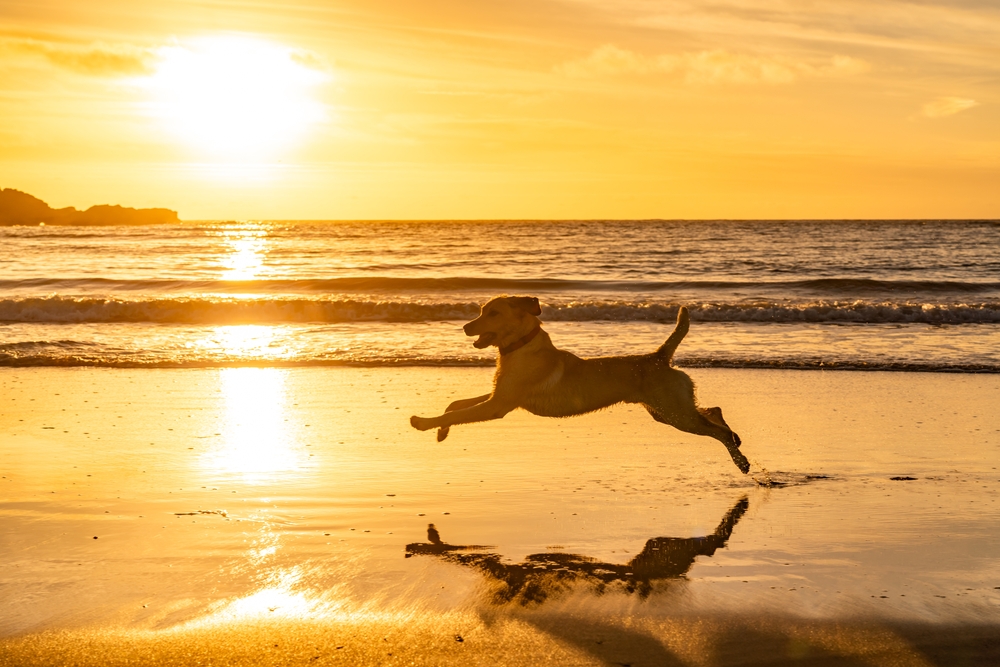Many dogs love the water, and summer is a great time to enjoy water-related activities together. However, pools and natural bodies of water can pose a threat to your four-legged friend. Our Boca Midtowne Animal Hospital team wants you and your pet to have fun—and stay safe—when you make a splash, so we provide water safety tips for your dog.
#1: Safely introduce your dog to water
Not all dogs know instinctively how to swim. Breeds such as golden retrievers, Chesapeake Bay retrievers, Portuguese water dogs, and Newfoundlands are typically extremely strong swimmers, but brachycephalic breeds, including bulldogs, French bulldogs, pugs, and Pekingese, have short, flat faces that make breathing difficult, especially in water, and they tend to tire quickly. In addition, some dogs, such as Basset hounds and corgis, have short legs that make paddling difficult, and they may have a hard time staying afloat.
When introducing your dog to water, understand their breed, and never force a reluctant dog to enter the water. Choose a quiet, shallow area, and keep your dog on a close leash so you can rescue them if they have difficulty. Start by letting them walk in the water, and gradually let them get deeper, holding their body with your arm until they get used to paddling. Keep the first swimming session short to ensure they don’t get too tired.
#2: Purchase a dog life vest
When taking your dog boating, always ensure they wear a properly fitted life vest. This is also useful if you want to spend time around a pool or natural water body, but your dog is not a good swimmer. A life vest not only keeps your dog afloat but can also help you keep watch when they are enjoying a swim. In addition, the life vest handles make rescue easier if your dog is in trouble. Ensure the vest is easy to get on and off, fits snugly enough to keep your dog’s head above water, and allows your dog to move easily in the water and on land.
#3: Bring water for your dog
Splashing in the water is thirsty business, but you should bring bottled water and a collapsible water bowl, because pool, pond, and lake water, and other natural water sources, can be dangerous for your four-legged friend. Offer your dog frequent drinks so they aren’t tempted to drink potentially toxic or contaminated water.
#4: Never leave your dog unattended around water
Even the strongest swimmers can get tired or find themselves in an emergency situation, and your dog can quickly drown if you can’t help. Watch your furry pal closely, monitor them for signs of tiring, and make them take frequent breaks to ensure they don’t become exhausted.
#5: Protect your dog from sunburn
Playing all day in the sun and near the water can put your dog at risk for sunburn, especially if they are lightly colored or their coat is thin. Tips to protect your furry pal from sunburn include:
- Choose a pet-specific sunscreen — Many common ingredients in human sunscreens are toxic to dogs, so choose a dog-specific sunscreen to ensure the product is pet-safe.
- Test the product — Apply the sunscreen to a small area to ensure your pet doesn’t react.
- Apply the product thoroughly — Once you verify the product is safe for your dog, apply the sunscreen to vulnerable areas, such as the bridge of the nose, the skin around their lips, ears, abdomen, and any thin-coated spot.
- Prevent removal — Do not allow your dog to lick for about 10 to 15 minutes so the sunscreen is absorbed.
- Reapply the sunscreen — Reapply your dog’s sunscreen every four to six hours and after they have been in the water.
#6: Ensure your dog knows how to exit the pool
Dogs can find leaving the pool difficult, so ensure they can locate the pool steps and they don’t tire themselves trying to claw their way out over the edge. If your pool has only a ladder, consider installing a ramp that will help your dog safely exit the pool.
#7: Protect your dog from blue-green algae
Blue-green algae blooms can be problematic, and you should be cautious when you take your pet to lakes and ponds. Cyanobacteria cause the bloom, which is most commonly found in non-flowing fresh water, but can occur in still creeks and rivers. Blue-green algae occur naturally in Florida and multiply quickly in sustained hot weather, stagnant water, and polluted storm runoff. Algae blooms typically clump together near the water surface and vary from bright green to brown. To protect yourself and your dog, avoid natural water sources that:
- Smell bad
- Appear discolored
- Have foam, scum, or algal mats on the surface
- Have dead fish in the water or on the shore
#8: Give your dog a bath

Pool chemicals and contaminants in natural water sources can harm your dog. Rinse off your four-legged friend thoroughly or give them a bath after they go swimming to remove these substances from their coat to ensure their skin isn’t irritated and to ensure they don’t ingest potentially dangerous toxins when they groom.
These tips should help you and your dog have a fun-filled water experience. However, if your dog ingests pool water or is exposed to blue-green algae, contact our Boca Midtowne Animal Hospital team, so we can provide the care they need.








Leave A Comment